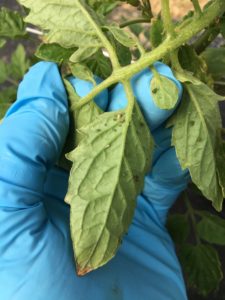Sweet Corn
The black light trap network is complete at this time. To date, one corn earworm (CEW) was captured at Eldora, Cape May County. A very few European corn borer (ECB) moths have been captured this past week, indicating that as warmer weather begins to arrive, we should see increasing numbers over the next several weeks. This pest poses little threat at this time, as they are few in number and the earliest sweet corn plants are only just reaching suitable size to support larvae.
The highest nightly trap catches of ECB for the week ending 5/20/20 are as follows:
| Downer 1 |
| Hackettstown 1 |
| Medford 1 |
Cole Crops
No imported cabbageworm (ICW) or diamondback moth larvae (DBM) have been found in cole crop plantings in central and northern NJ this week. These infestations should increase rapidly as the spring season progresses. ICW adults are very active on warm afternoons. Check 5 consecutive plants each in 10 random locations throughout the planting, paying particular attention to the innermost leaves where ICW often feed. Consider treating if caterpillars are found on 10% or more plants that are in the 0-9 true leaf stage. From 9-leaf to the early head stage (in broccoli, cauliflower, and cabbage) infestations up to 20% may be tolerated. Once heads begin to form, a 5% threshold should be observed to protect the marketable portion of the plant. For leafy greens such as collards and kale, 10% plants infested is the threshold throughout. 
Some populations of DBM are resistant to carbamate and synthetic pyrethroid insecticides. The lack of DBM control with these insecticides has been noted in NJ previously. It is important to distinguish between common cole crop pests for this reason. DBM larvae grow to a length of approximately 0.5”, and taper toward both ends (see photo at right). These caterpillars thrash violently when disturbed. ICW grow to a length of approximately 1.25” and are covered with short hairs. Newer chemistries that specifically target caterpillar pests are effective against DBM as well as all other caterpillar pests of cole crops. These materials include (active ingredient – trade name (IRAC* code)):
Spinosad/Spinetoram – Entrust(OMRI)/ Radiant (5)
Chlorantraniliprole – Coragen (28)
Cyantraniliprole – Exirel (28)
The IRAC group 5 insecticide, Entrust, is OMRI approved for organic production. Insecticides based on the soil-inhabiting bacterium Bacilllus thuringiensis (B.t.) may also be effective on caterpillar pests of cole crops. Examples include Xentari and Javelin.
Flea beetles are very active in many plantings, particularly during the warmer days. These pests have a preference for the “hotter” flavored crops like arugula, mustard greens, and turnip greens. They also attack Tuscan or lacinato kale frequently. Plants may be protected with at-planting, soil-applied neo-nicotinoid insecticides (see the Commercial Vegetable Production Recommendations for products). An OMRI approved foliar material for flea beetle management is Pyganic. This product will provide knock-down of flea beetles, but may need to be applied frequently on preferred host crops.
Allium leaf miner
Captures of allium leaf miner (ALM) adults on sticky cards have dropped from very low to none over the past week in Mercer and Hunterdon counties. The spring flight of this insect pest of onions, leeks, garlic, scallions and chives appears to have ended.
Tomatoes
Field scouting of outdoor and high tunnel tomatoes continues. As yet, only aphids (see photo at right) have been detected. Typically, aphids and two-spotted  spider mites are the first pest problems to occur on high tunnel tomatoes. Growers should check these tomatoes at least weekly, and note the presence of mites or aphids. Mites in particular should be treated early, so that they do not build to a population that becomes difficult to manage. Aphids are often preyed upon by syrphid fly maggots, ladybird beetles, and serve as hosts for parasitic wasps. However, if cool weather dictates that the sides of the tunnels remain down, parasitism and predation may not occur. Generally, aphids become a nuisance on tomatoes when their droppings accumulate on the surface of developing fruit. If no fruit are present, chemical control is less urgent. Consider treating if aphids are found on multiple sites in a 5-site sample, and fruit are beginning to develop.
spider mites are the first pest problems to occur on high tunnel tomatoes. Growers should check these tomatoes at least weekly, and note the presence of mites or aphids. Mites in particular should be treated early, so that they do not build to a population that becomes difficult to manage. Aphids are often preyed upon by syrphid fly maggots, ladybird beetles, and serve as hosts for parasitic wasps. However, if cool weather dictates that the sides of the tunnels remain down, parasitism and predation may not occur. Generally, aphids become a nuisance on tomatoes when their droppings accumulate on the surface of developing fruit. If no fruit are present, chemical control is less urgent. Consider treating if aphids are found on multiple sites in a 5-site sample, and fruit are beginning to develop.

